Gardening Tips
Best Companion Plants for Your Vegetable Garden
Are you struggling with pest problems or underwhelming vegetable yields in your garden? Maybe it’s time to explore the amazing world of companion planting! If you’ve ever wondered how to make your vegetable garden thrive naturally, companion plants might be the secret you’ve been searching for.
Companion planting is more than just a trend; it’s an age-old gardening method that pairs different plants together for mutual benefits. These strategic plantings can help boost growth, improve pest resistance, and even enhance the flavor of your harvest. Let’s dive into how you can create the perfect vegetable garden with the best companion plants.
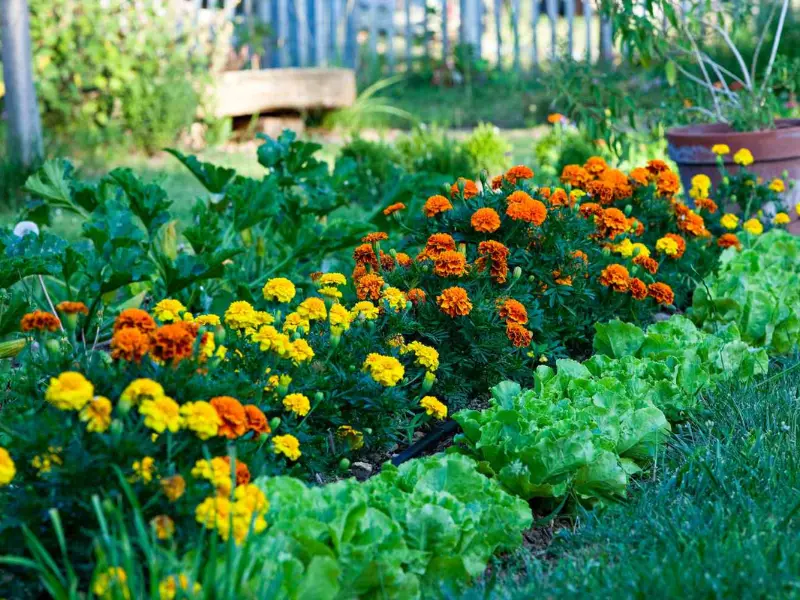
What Are Companion Plants?
Companion plants are those that, when grown together, benefit each other in some way. These benefits can include natural pest control, enhanced growth, or even improved flavor. For example, planting basil next to tomatoes can improve the flavor of the tomatoes while also deterring harmful pests like aphids.
Incorporating companion planting into your vegetable garden can lead to a healthier, more productive space. Let’s look at the best companion plants that you can incorporate into your garden.
Companion planting harnesses natural relationships between plants to improve growth and health. Some plants repel pests with their strong scents, others attract beneficial insects, while certain combinations simply help each other thrive. This organic gardening technique can significantly reduce your reliance on chemical controls and create a more resilient garden ecosystem.
What Vegetables Not to Plant Together
Not all plants make good neighbors. Certain vegetable combinations can hamper growth or increase pest problems. Fast-growing plants may overshadow slower varieties, while some compete aggressively for nutrients. Before planning your vegetable patch, consider these combinations best kept apart:
Brassicas (cabbage family) with strawberries
Fennel with most vegetables (it tends to inhibit growth)
Browse our list of the most effective companion plants for your vegetable garden, below.
Companion Plants for Vegetable Garden
Basil and Tomatoes
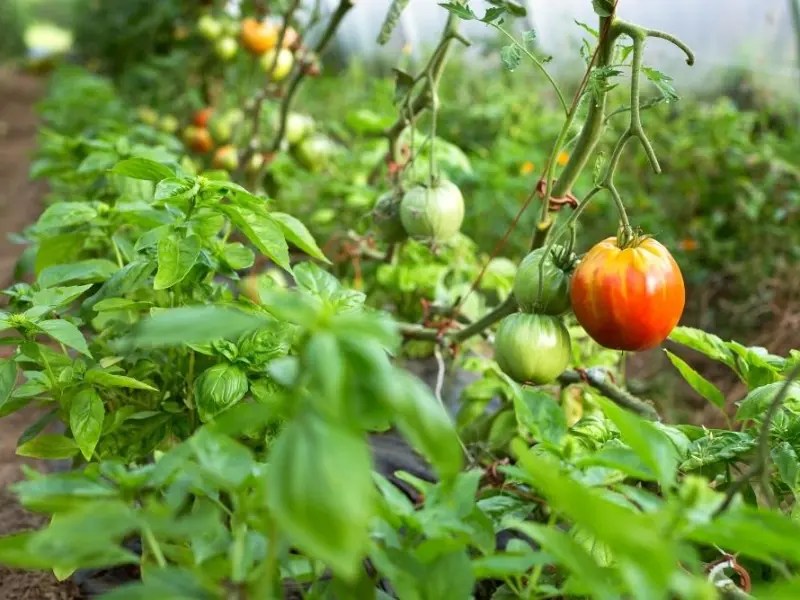
The aromatic leaves of basil do more than complement tomatoes in the kitchen – they help them in the garden too. Basil repels tomato hornworms and flies, while potentially improving the flavour of your tomatoes. Plant several basil plants around tomatoes in beds or containers for best results.
Read more:How to Grow Tomatoes from Seeds: The Ultimate Beginner’s Guide
Nasturtiums and Cucumbers
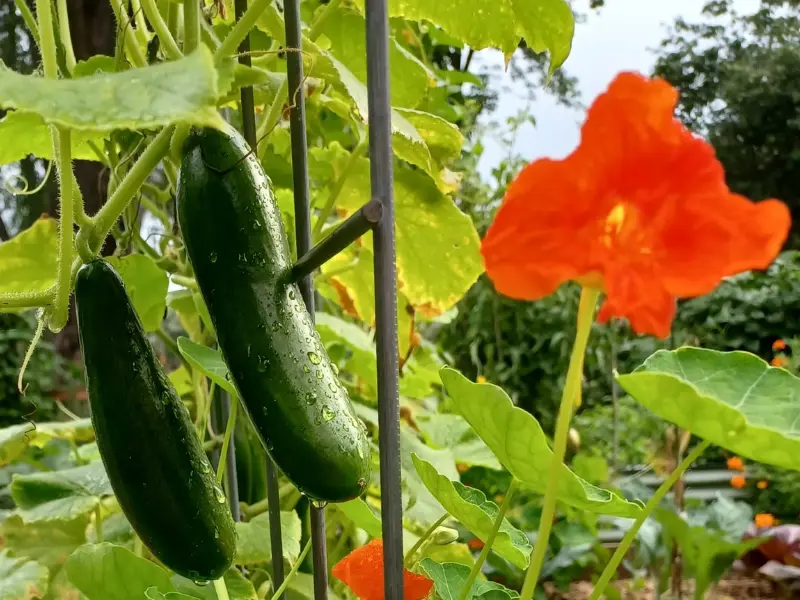
Nasturtiums act as a sacrificial plant, luring aphids away from your valuable cucumber crop. Their bright flowers not only add color to the vegetable garden but also attract pollinators that can improve cucumber yields. The peppery flowers and leaves are edible too – a bonus harvest from your companion planting.
Dill and Cabbages
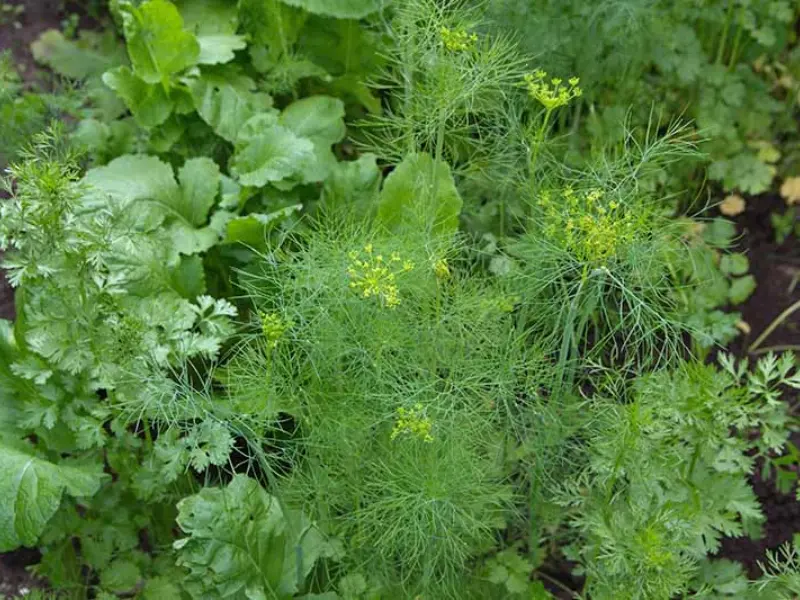
The feathery foliage of dill attracts beneficial insects such as hoverflies and parasitic wasps, which prey on cabbage worms and other pests that attack brassicas. Plant dill nearby, but not too close as it can become quite tall and potentially shade smaller plants.
Chives and Carrots
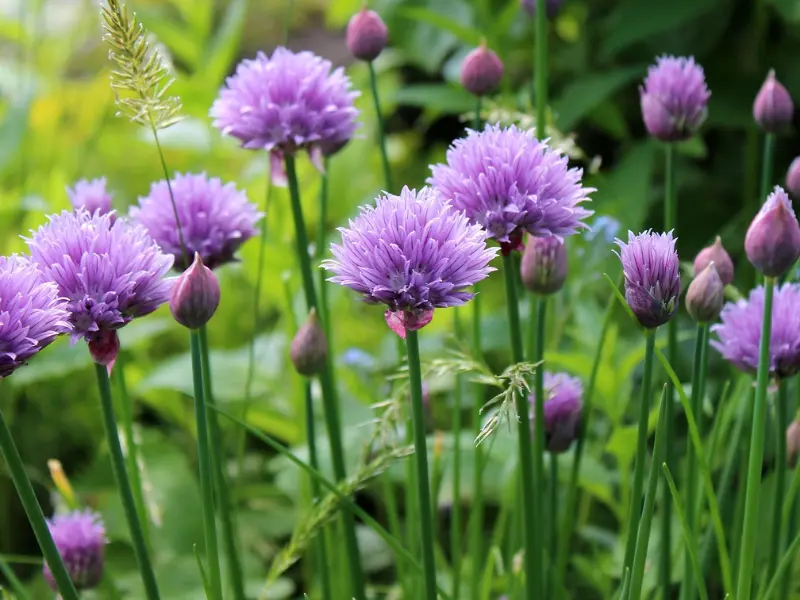
Chives make excellent companions for carrots, as their strong scent helps confuse and deter carrot flies. This pest can devastate your carrot crop but struggles to locate its target when masked by the allium smell. The pretty purple flowers also attract pollinators to your plot.
Read more:8 Beautiful Herbs to Enhance Your Flowerbeds – Create an Edimental Paradise
Marigolds and Courgettes
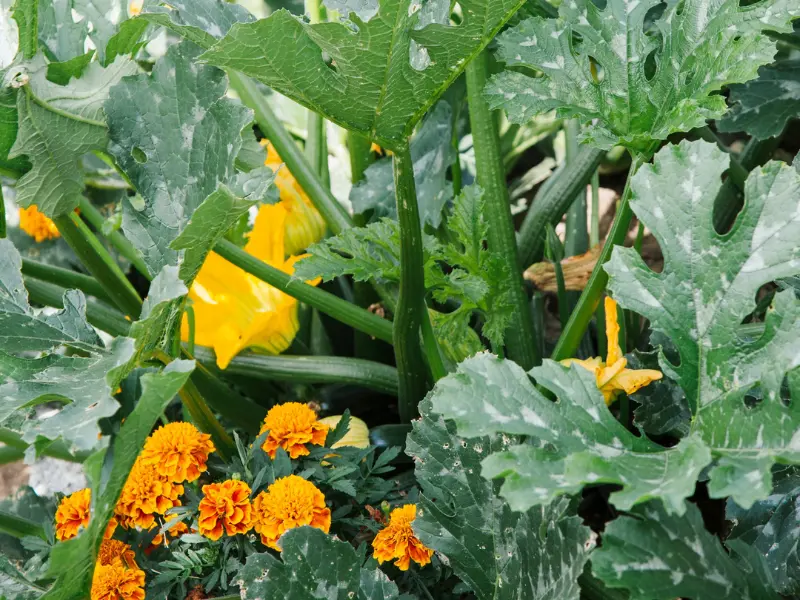
French marigolds (Tagetes) are workhorses in the vegetable garden. Their roots release compounds that deter soil nematodes, while their bright flowers attract pollinators to courgette blossoms. This is especially valuable during cooler weather when pollinator activity may be reduced, helping ensure a better fruit set.
Beans and Corn
This traditional companion planting combination creates mutual benefits. Corn provides tall, sturdy support for climbing beans, while the beans fix nitrogen in the soil, feeding the hungry corn plants. Together, they create efficient use of garden space and improve the harvests of both crops.
Radishes and Spinach
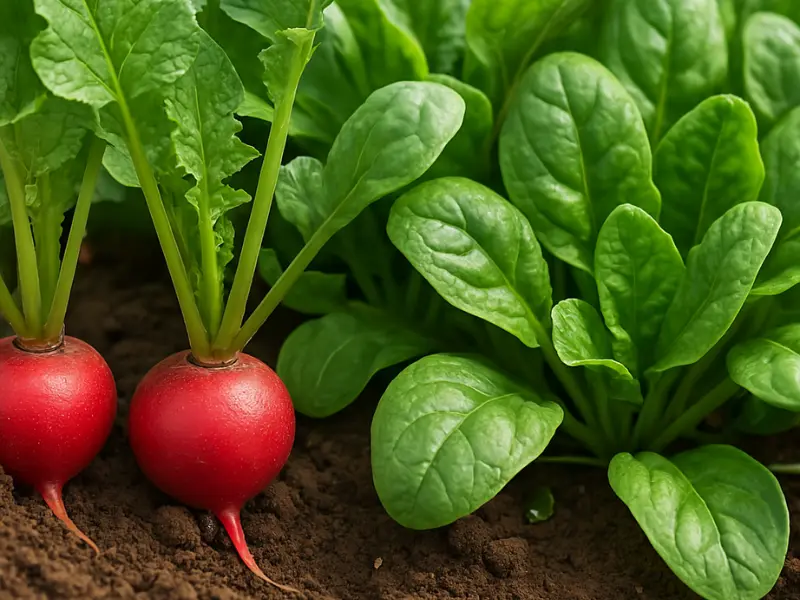
Fast-growing radishes are excellent companions for slower-developing spinach. The radishes break up the soil as they grow, improving conditions for spinach roots. Harvest the radishes first, leaving more space for spinach to expand. This combination makes efficient use of garden space and timing.
Rosemary and Beans
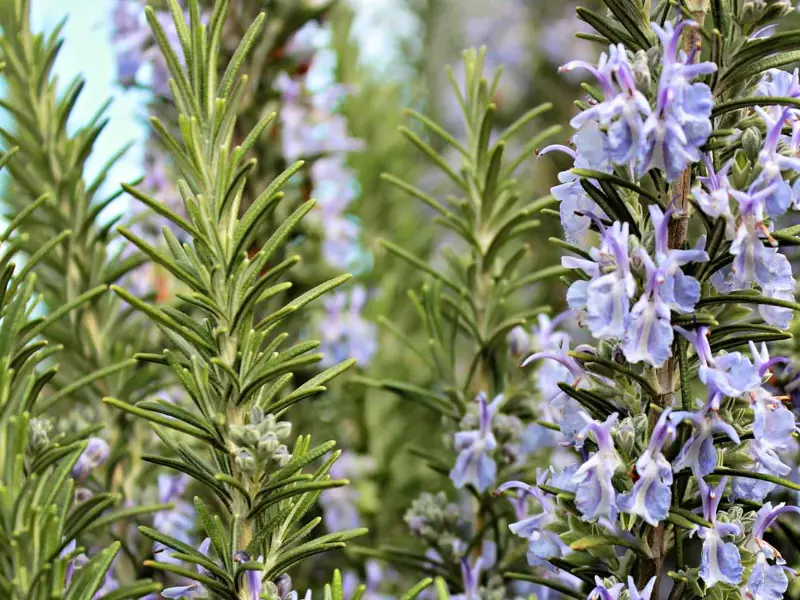
Rosemary‘s strong aroma helps deter bean beetles and other pests that commonly affect bean plants. Plant this Mediterranean herb along the edges of your bean patch where it won’t shade the growing crop but will still provide pest protection. The blue flowers also attract pollinators.
Lettuce and Tall Vegetables
Lettuce makes an excellent companion for taller vegetables like Brussels sprouts, broccoli, or sweet corn. The leafy greens thrive in the dappled shade provided by taller plants during hot weather while making efficient use of garden space. This partnership extends your growing season and maximizes yield per square meter.
Borage and Strawberries
Borage is a beneficial companion for strawberries, reportedly improving their flavor and yields. The striking blue flowers attract pollinators, while the hairy leaves deter pests. Borage is also said to increase disease resistance in nearby strawberry plants, making this a powerful partnership for your fruit patch.
Read more: 8 Vegetables to Plant in Spring for a Summer Harvest
How to Choose the Right Companion Plants for Your Garden
Choosing the right companion plants depends on several factors, including the growth habits of your vegetables, the climate, and the space available in your garden. Here are some tips for making the best choices:
Consider Growth Habits: Pair plants that grow well together without competing for space or light. For example, root vegetables like carrots and onions don’t compete with leafy greens like spinach or lettuce.
Think About Soil Needs: Some plants, like legumes, are great at fixing nitrogen in the soil, which can benefit nitrogen-hungry plants like corn.
Check Compatibility: Avoid planting species that are known to compete for nutrients or space, such as planting root vegetables with other root vegetables.
Plan for Pest Control: Many companion plants are natural pest repellents. For example, planting garlic near your roses will help keep aphids away, while marigolds are excellent at repelling nematodes.
Companion Planting Mistakes to Avoid
While companion planting can be incredibly effective, there are a few common mistakes you should avoid to ensure your garden thrives:
Planting Incompatible Species Together
Not all plants get along. For example, you should avoid planting beans and onions together, as onions can inhibit the growth of beans. Similarly, certain plants like tomatoes and potatoes are often more susceptible to diseases when grown close together, so they should be kept apart.
Overcrowding and Poor Layout
While companion planting is meant to increase the efficiency of your garden, overcrowding can actually limit growth. Make sure to leave enough space between your plants to allow air circulation and prevent disease.
Not Considering Soil Quality
Soil quality plays a critical role in the success of companion planting. Some plants, like beans and peas, can improve soil quality by fixing nitrogen, but if your soil is already rich in nitrogen, these plants may not be necessary.
Common Questions About Companion Planting
Q1: Can companion plants really reduce pests in my vegetable garden?
Absolutely! Many companion plants act as natural pest repellents. For example, marigolds help keep nematodes away, and basil deters aphids from tomatoes. Incorporating these plants into your garden can significantly reduce your reliance on chemical pesticides.
Q2: What are the best companion plants for beginners?
For beginners, start with easy-to-grow companions like basil, marigolds, and beans. These plants are not only easy to care for but also provide great benefits to your vegetable garden.
Q3: How close should companion plants be to each other?
The distance between companion plants depends on the type of plant and the space it needs to grow. However, a general rule of thumb is to plant them far enough apart to ensure each plant gets enough sunlight, air circulation, and nutrients.
Q4: Are there any companion plants that help improve soil quality?
Yes! Legumes, such as beans and peas, are excellent companion plants because they fix nitrogen in the soil, enriching it for other plants. You can pair them with nitrogen-hungry plants like corn or peppers to boost their growth.
By thoughtfully combining these companion plants in your vegetable garden, you’ll create a more balanced growing environment, reduce pest problems naturally, and potentially increase your harvests – all while creating a more diverse and attractive plot.
For all your seed-starting needs, from premium seed varieties to expert growing kits, browse theBest Garden Seedand get everything you need to kickstart your summer harvest!
More Gardening Inspiration:
Everything about Gardening Jobs for April You’ll Ever Need
